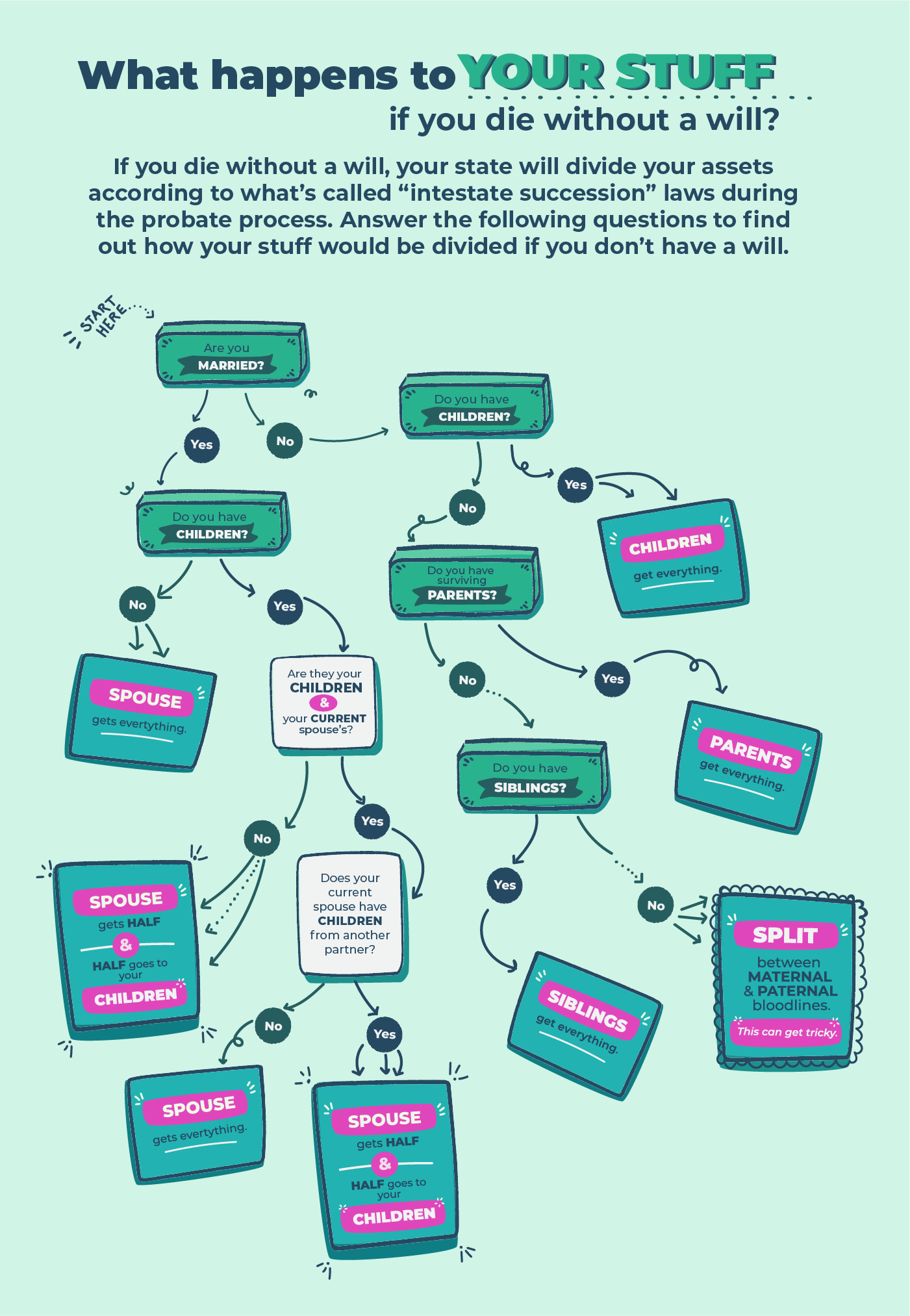Most people know that a will is an important document if you want to ensure specific people inherit your assets, like a house, car, or heirlooms, after your death. A valid will governs how your assets will be split, but it will still be subjected to the process of probate. If you want to avoid the lengthy process, there are some ways through estate planning to pass assets without probate.
How can I avoid or speed up probate?
It’s important to understand that having a will isn’t enough to avoid the probate process. Probate is the process of proving the will or passing assets of the decedent according to your state’s intestate succession laws in the absence of a will.
Probate is a lengthy and costly court proceeding, so if you want to help your loved ones speed up the process or avoid it altogether, here are six things you can do. Depending on the circumstances, probate may be unavoidable, like if the decedent has creditors, but there are some things that people can do before their death to ensure the process goes smoothly for their loved ones.
7 ways to speed up or avoid the probate process
- Have a will executed according to your state’s requirements
- Sign a self-proving affidavit
- File for summary administration if possible
- Designate and update the beneficiaries listed on your assets
- Hold title on a property so it automatically transfers to the co-owner
- Record a Transfer-on-Death or Enhanced Life Estate Deed
- Create a living trust (also known as a revocable trust)
Have a will executed according to your state’s requirements
The first step is to have a will. Without a will, your personal and real property will be passed according to your state’s intestate succession laws. Intestate simply means you had no will and last testament or the will you created wasn’t valid.
In order for a will to be valid, it must be signed by you and two witnesses. You may also need to get it notarized depending on where you live.
What if there is no will?
In the interview with Pamela, she explains the difference between testate and intestate succession. Testate means that a person left a valid will. Intestate means there is no valid will. In both cases, probate is needed to pass the assets to beneficiaries, but if there is no will, your state’s intestate succession laws will be applied during the probate process.
The state draws something of a “family tree” to determine who will inherit the estate. Pamela mentions that there is a common misconception that close family members automatically inherit the home or other assets. However, if the surviving spouse or children aren’t listed on the will or the title, the assets may be split in a way that the decedent finds undesirable.
Here is a chart of how assets are split according to Florida’s Intestacy Succession Law:

If you have specific wishes for your stuff to go to specific friends and family but have no will, the probate court will be bound by these laws.
Sign a self-proving affidavit
Second, when creating your will, be sure to have your witnesses sign a self-proving affidavit. This isn’t required in the state of Florida, but it’s an excellent way to expedite the probate process. Without it, the authentication process of the will requires the original witnesses to be located and attest to the validity of the will. If the witnesses aren’t located or they are incapacitated or deceased, either the personal representative named in the will or another person with no interest in the estate would need to confirm the validity of the will under oath.
File for summary administration if possible
This third option is possible if probate is required and if you live in the state of Florida. There’s an option to file for a summary administration if:
- The decedent’s assets are valued at less than $75,000
- and/or the decedent has been dead for longer than 2 years.
Summary administration usually takes about three to six months depending on your circumstances. If your circumstances don’t meet these requirements, a formal administration of probate is needed. This can take anywhere from seven to nine months.
Designate and update beneficiaries and co-owners named on assets
The fourth way to avoid or speed up probate is to ensure that assets that are passed via named beneficiaries on the contract are designated and/or updated. There are some valuable assets that don’t go through your will and, therefore, they won’t be subjected to the probate process IF the beneficiary is still living or isn’t listed as “my estate.”
Some examples of non-probate assets that list a beneficiary are:
- Life insurance proceeds
- Funds in a retirement account like a 401(k) or IRA
- Securities held in a Transfer-on-death Registration
- Payable-on-death bank accounts
- The property you own with someone else in joint tenancy or tenancy by the entirety
- Property that has been transferred to a living trust
The caveat here is that if the person you name as the beneficiary on the account or hold title with dies before you do, the asset may be subjected to probate to determine who has a right to inherit it.
In addition to keeping the beneficiary and co-owners updated, another way to avoid probate is to create joint bank accounts or Payable-on-Death (POD) bank accounts. Banks have these forms available to fill out, so call or visit your bank to see about this. As long as you are living, the person named to inherit the POD has no claim to it.
This is a great way to keep large sums of money out of probate. After your death, the beneficiary simply contacts the bank, confirms proof of death and their identity, and collects the funds held in the account.
Hold title on a property so it automatically transfers
If you have a property you want to leave specifically to your spouse or domestic partner, be sure to hold title on the deed so probate isn’t needed. You can skip the probate process altogether for your titled assets, like your home, with proper estate planning.
There are a few ways to hold title to avoid probate:
- Hold title by Joint Tenancy with Right of Survivorship
- Hold title by Tenancy by the Entirety
- Community Property with Right of Survivorship
Joint Tenancy with Right of Survivorship is a way to hold ownership of property. It means that property is automatically passed to the surviving owner(s) when one owner dies. This works well for married and unmarried couples who buy valuable property together or friends or siblings who are co-buying property. This can work for homes, cars, bank accounts, or other valuable assets.
This method avoids probate completely even if the deceased tenant had creditors because they would have no entitlement to that share after death, and it would not be included in the estate to pay any final bills.
There are four requirements or “unities” for two or more people to take ownership by Joint Tenancy with Right of Survivorship:
- Unity of time: the owners must take possession of the property at the same time.
- Unity of title: the owners must take title by the same instrument (the deed usually).
- Unity of interest: Each tenant or owner has equal interests in the property. So, if there are two owners, each has a 50% interest. If there are three owners, each as a third interest. This is required even if one of the owners paid for most or all of the property.
- Unity of possession: Each owner has a right to possess or use the property in its entirety even if though they may not own 100% of the property.
What are survivorship rights?
It’s important to understand two things about Joint Tenancy with Survivorship Rights. 1. The other owners named on the instrument take equal parts of the decedent’s share. 2. None of the owners can transfer their share to beneficiaries in their wills.
Tenancy by Entirety is only allowed for owners who are legally married. This method of holding title views the couple as one person for legal purposes. Ownership is conveyed to them as if they are one person, and when one spouse dies, the title is transferred to the surviving spouse. This method, like joint tenancy, requires no will, probate, or other legal action to take place to transfer the title.
The asset is also protected or immune from the judgments against any one of the spouses, so creditors also have no entitlement to the property.
Community Property with Survivorship Rights is another way for married couples to hold title, but it’s only applicable in a few states like Arizona, California, Nevada, Texas, and Wisconsin. Community Property is a form of ownership where either spouse has the right to dispose of one half of the property or will it to another party. However, survivorship rights may be added to allow one spouse’s interest in the community property assets to pass probate-free to the surviving spouse.
Record Transfer-on-Death Deed or Enhanced Life Estate Deed
Transfer-on-Death deeds are allowed in some states. This means you can prepare a deed now that will take effect only at your death. The deed must be prepared like a regular deed. It must be signed, notarized, and recorded with the county clerk. The deed must explicitly state that it is not valid until death.
Some of the states that allow Trans-on-Death deeds are:
- Alaska
- Arizona
- Arkansas
- California
- Colorado
- District of Columbia
- Hawaii
- Illinois
- Indiana
- Kansas
- Minnesota
- Missouri
- Montana
- Nebraska
- Nevada
- New Mexico
- North Dakota
- Ohio
- Oklahoma
- Oregon
- South Dakota
- Texas
- Virginia
- Washington
- West Virginia
- Wisconsin
- Wyoming
Other states recognize Enhanced Life Estate Deeds sometimes called Ladybird Deeds (named after President Johnson’s wife, Claudia Alta “Lady Bird” Johnson). Florida, Michigan, Texas, Vermont, and West Virginia are the only states to accept this type of deed.
The owner of the property, or “life tenant”, maintains possession and use over the real estate while they are living. The life tenant may also take out a second mortgage, refinance, or sell the property without the consent of the named beneficiaries on the Ladybird Deed just as they would if no such deed was created.
Like the Transfer-on-Death Deed, the Enhanced Life Estate Deed must be prepared, signed, and recorded in the country clerk’s land records like any other instrument used to transfer title. This type of deed also allows the property to pass directly to beneficiaries without probate.
Create a Living Trust
The last way to avoid probate is to create a living trust, which is also known as a revocable trust. This is essentially a contract that you make with yourself that creates a plan for how your assets will be managed.
The trust is set up with three main roles:
The Grantor. This is the person who creates the trust. This person decides which assets will be placed in the trust and how they will be managed due to a period of disability or distributed upon the Grantor’s death. All assets are then retitled to the trust.
The Trustee. This is the person who manages the trust. Unlike in an Enhanced Life Estate Deed, the trust manager will have all the power over the assets to buy, sell, gift or loan them. The Grantor acts as the Trustee when they are alive, but if they become incapacitated or die, the Successor appointed in the trust takes over managing the assets.
The Beneficiary. This is a person who gets to use and enjoy the assets named in the living trust. The grantor also occupies this role while they are living. Upon their death, the assets are passed to the beneficiaries without the need for probate.
This is a streamlined way to ensure that your estate is managed according to your wishes during illness or after your death. Many of these options may require the help of an attorney, so be sure to reach out to one in your area.









